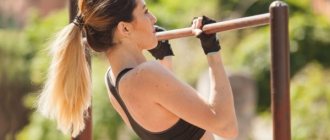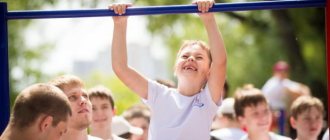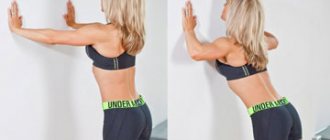The horizontal bar is considered an effective tool for developing several muscle groups at once.
The main emphasis of the load falls on the back, but with its help it is quite possible to pump up your arms, shoulders and abs.
There are several exercises that will help you achieve your goal or allow you to diversify your training process.
With the help of a horizontal bar you can develop not only your back, but also your arms. Moreover, we are talking not only about the biceps, for the development of which there is a separate exercise on the bar, but also the triceps, as well as the forearms.
How can you pump up your arm muscles on the bar?
The load on the forearm also occurs when performing any exercises on the bar.
These can be both classic pull-ups and more complex ones, for example, static elements, when an athlete holds the weight of his body, fixing it perpendicular to the rack of the apparatus, that is, providing a static load.
It’s also possible to pump up your biceps. To do this, you need to use a reverse grip and place your hands close to each other. In this position, it is the biceps that will receive the maximum load, especially its outer part.
Important! Classic pull-ups place more stress on the shoulders and back. Additionally, the load falls on the triceps; it can be strengthened with the help of auxiliary movements without a horizontal bar, for example, push-ups with a narrow grip or reverse push-ups.
Be sure to check out:
Swinging on the uneven bars and horizontal bar: an effective training program Pull-up program on the bar: technical nuances and tips Pull-ups on the horizontal bar for the health and beauty of the body Pull-ups on the horizontal bar: what muscles work
Execution technique
There are features in each pull-up variation. There is only one thing in common - you need to try to first bring the shoulder blades together, and only then bend the elbows.
Classic medium grip pull-up
This is a medium straight grip, that is, the palm in the hang is directed away from the face of the person performing the exercise. If the palm and fingers point forward towards the face, then this is a reverse grip.
This pull-up option is suitable for those who need to pass a test in a military or physical education institution; it develops the overall strength of the back muscles. For beginners, this pull-up has a lot of advantages - first of all, it develops the biceps and back in a balanced way.
The sequence of actions is as follows:
- You need to grab the bar with a straight medium grip shoulder-width apart, a slightly wider grip is allowed - 2-3 cm, but not narrower;
- They climb onto the high crossbar using a support or from a jump. The second option is not recommended for beginners, whose weak ligaments may not provide stability in the shoulder joint. Simply hang on a low bar with your knees bent;
- First you need to stabilize your shoulder blades and shoulders while hanging. To do this, you should stop swaying and bring your shoulder blades towards your spine so that your shoulders seem to “open” to the sides;
- After this, a pull-up is performed - the chest is pulled towards the bar, the elbows are bent and moved to the sides. The body is held at a slight angle to the crossbar;
- As soon as you touch the crossbar at the top, you should smoothly lower down;
- The work takes place in a controlled style, raising and lowering the body along an arched trajectory; a straight line can be drawn only if you take the athlete’s tailbone as a reference point. The shoulders arc every time the athlete pulls up and down
This version of pulling up requires control over the lowering too. If you constantly lower yourself into a “dead hang,” that is, fully extend your elbow and shoulder joints, the movement will be much more difficult. Beginners are not recommended to work from a “dead hang”; this is a variation for intermediate ones.
How to Learn to Do Pull-Ups - 5 SIMPLE STEPS (Pull-Ups on the Horizontal Bar for Beginners)
Wide grip pull-up technique
There is little difference here, except that it is almost impossible for a complete beginner to do this exercise right away without any preparation. The movement is anatomically more complex; the wider the shoulders and the shorter the arms, the more difficult it is.
The exercise is performed like this:
- Hanging on the horizontal bar is taken with a grip 5-10 cm wider than the shoulders, but it should be comfortable; if the athlete experiences pain at the start of the exercise, the grip is too wide;
- As you exhale, the shoulder blades are brought together to the spine, the chest seems to be pushed forward, the arms are bent at the elbows, and the chest is pulled up to the crossbar;
- As you inhale, smoothly return to the starting position;
- In the lower part of the amplitude, you cannot relax the body too much, so that the shoulders go to the ears. This will create unnecessary tension in the trapezius when performing the movement, and will not allow the back muscles to be pumped effectively.
In the professional literature, this exercise is also called a wide pronated grip pull-up.
Narrow reverse grip
Many trainers recommend starting with this variation for women and those who have a genetically weaker back.
The technique is like this:
- The hang is accepted with straight arms, palms shoulder-width apart, you should carefully stretch your arms up, grab onto the horizontal bar so that it lies in the middle of your palm, and not on your fingers;
- This exercise is the only variation where the first movement is bending at the elbow joint. As you exhale, you need to bend your elbows and bring your chest to the horizontal bar;
- The lowering is slow; a beginner also does not need to go into a “dead hang” with elbows inserted.
Important note: The narrow reverse grip is better for training the shoulder muscles, but is not recommended for those with rotator cuff problems. In case of shoulder injury, a medium straight grip is optimal, and only after rehabilitation.
Pull-up on a horizontal ladder
This is not quite a pull-up in the classical sense of the word. The athlete's feet are on the floor. To perform this movement, you need to hang straight on the bar so that your back drops down and place your feet on the floor. Next, the back is brought out parallel to the crossbar, and the arms are perpendicular.
The exercise itself resembles a pull-up due to similar mechanics, but most of all it resembles a mid-block row to the belt. This movement develops the lats and prepares the athlete for a conventional pull-up.
“Australian” pull-ups are also done on ladders on the playground. Here it is important to hang so that your shoulders are at the level of the bars on which your arms are fixed, and your feet are secured so that the spine is in a plane parallel to the floor.
It is worth progressing towards a regular pull-up when you can perform the Australian pull-up for 15-20 repetitions.
Progression in pull-ups looks like this - Australian, negative repetitions, pull-ups with a rubber shock absorber, classic pull-ups.
GRIP DIFFERENCE IN PULL-UPS. 6 Types. BIOMECHANICS
A set of the best exercises for all muscle groups
There are many horizontal bar exercises that horizontal bar lifters should include in their routines. These are basic exercises, like pull-ups, as well as more complex ones that require special training:
| Pull-ups | Classic pull-ups are performed with a straight grip, when the hands hold the horizontal bar from above. The grip is either medium or wide. The body rises up without swinging or jerking, and falls slowly. At the top point you can take a short break. The exercise loads the upper back and its middle, as well as the shoulders. A small load falls on the triceps. |
| Head pull-ups | Pull-ups are performed in the same way as classic ones, only the head goes behind the horizontal bar in the top position. In this position, the load shifts to the upper back and trapezius. |
| Reverse grip pull-ups | They are performed exactly the same as the standard version, but the hands are either as close to each other as possible, or an average grip width is used. Also, the palms need to be turned, that is, a reverse grip is used. The load is shifted to the biceps and forearms. |
| Exercise corner | This exercise allows you to pump up your abs. You need to hang on the horizontal bar and raise your legs to ninety degrees. At the top point, you can stop for a second or two, that is, take a break. |
| One arm pull-ups | They are performed only by trained athletes, as they require significant skills. You can start by hanging on one hand, clasping your wrist with the other. The exercise develops the shoulders, arms and forearm. |
| Vis | A static exercise that is required to develop endurance, as well as to strengthen the wrist and forearm. You can hang by grasping the horizontal bar with your hand or holding it with several fingers. |
These are just the most popular exercises; the training program may consist of other movements. The ones listed are included by beginners in order to maximally load the main muscle groups.
As for training your legs, it’s worth noting that you won’t be able to fully pump them up on the horizontal bar. It is necessary to include other movements, such as jumping and squats.
Exercises for girls on the horizontal bar
Content
Over the several decades that have passed since the emergence and spread throughout the world of such a sport as bodybuilding, for some reason many people have developed a clear stereotype that pull-ups for girls are an unnecessary type of exercise that can be neglected. Look for yourself - who mostly trains on horizontal bars on the street and in gyms? For the most part, exercises on the horizontal bar attract only representatives of the stronger half of humanity.
In principle, exercises on the horizontal bar for girls are indeed far from the most important and indispensable way to get a toned and slender figure, however, as an additional exercise machine that allows you to increase endurance and strength, as well as “tighten” and form important muscles, it is just perfect. Let's take a closer look at how exercises on the crossbar can help the fair sex.
What muscles can be used during horizontal bar exercises?
In most cases, pull-ups on the horizontal bar involve only the torso muscles, and a wide grip is very effective in creating that V-shaped figure desired by men. However, it is unlikely that many girls dream of developing the latissimus dorsi muscles - after all, this is not the main criterion for female attractiveness, but quite the contrary.
Working on the bar allows you to engage not only the back muscles, as many ignorant and inexperienced athletes (and women) mistakenly think. The deltoid muscles (that is, the muscles of the shoulders) and the muscles of the forearms, to a lesser extent - the triceps and biceps of the arms, as well as the muscles of the lower abs. In addition, you can tone the muscles of the buttocks, lower back and back of the thighs.
Exercises on the horizontal bar and growth
Nature does not endow every person with tall stature. If you are not satisfied with the number of centimeters that nature has measured for you, at a young age you can try to correct such injustice. To do this, you don’t even have to pull yourself up - just hang on the bar for as long as possible. In addition to stretching the intervertebral discs, this will very quickly strengthen the muscles of your forearms. To make this activity more effective, you can do the following:
- Torso twists - hang on the horizontal bar and begin to slowly rotate in a circle, first in one direction, then in the other.
- Partial pull-ups - while hanging on the horizontal bar, perform a partial pull-up (for example, half the amplitude), and then sharply lower yourself.
- Use additional weights - now in any store you can buy special pads with different weights (from 1 kilogram and above), which are conveniently and securely attached to your legs (or arms).
- Jump - stand under the horizontal bar, jump, hang for a while (for example, 10 seconds), then jump to the ground. Now jump again and hang for another 10 seconds. Repeat as many times as you have the strength to do.
- Hang upside down. For pulling, this option is more effective, but you will have to purchase special gravity boots. Their cost on average starts from 3,000 rubles.
At the same time, in no case should we forget about recovery after training and safety precautions. If this is your first time working out on the horizontal bar, do not expect that you will be able to hang on it for even one minute - the muscles of your forearms are not yet strong enough and will not withstand such a load. Do not rush to do the exercises and realistically assess your strength - it is very easy for an inexperienced athlete to injure a joint or strain a muscle.
Exercises on the horizontal bar to increase height are especially relevant for girls (and boys too) at school age. On average, after 17-18 years of age, body growth slows down and stops completely at about 24-25 years of age, and you are unlikely to be able to add a significant number of centimeters. However, each organism is individual - and you can still try.
What exercises can girls do on the horizontal bar?
If the goal of your training is not to build large muscle mass, but simply to maintain your figure in good shape, then you should pay attention to the following exercises:
- Choose your own pull-ups and grip, but don’t grab the bar too widely. Thus, the main load will be received by the muscles of the upper back, as well as the deltoids, triceps and biceps of the arms, and the muscles of the forearms. Pull yourself up as many times as you can cleanly, touching the bar with your chin, without swaying your body. For girls, classic pull-ups are useful not only because they allow you to get a sculpted and attractive back - they also keep the triceps in good shape, which for many people begin to sag with age, which is not very beautiful.
- Bend in the lower back. While hanging on the horizontal bar, try to bend back as much as possible at the lower back. This will engage the muscles of your lower back, buttocks and hamstrings, and will also stretch your abdominal muscles. As a separate exercise, this is unlikely to give a significant result, but as an addition to the warm-up or in between sets it is very useful. In addition, deflections on the horizontal bar are an excellent prevention of the development of diseases such as osteochondrosis and scoliosis.
- Leg raises. The question of how to pump up the lower abs has always worried a huge number of people who want to lose weight. It is in the lower abdomen that the largest amount of fat deposits accumulate, and it is here that they begin to appear first, instantly catching the eye. The essence of the exercise is simple - hang on the horizontal bar and raise your legs in front of you. This can be done in various variations: straight legs (many people call this exercise a “corner”), bent at the knees (the easiest method, suitable for beginners), raised together or alternately.
- Body rotations. While hanging on the horizontal bar, slowly turn your body in a circle. This will not only strengthen your forearms and joints, but will also tone your core stabilizer muscles, as well as your internal and external obliques, which contribute to a very attractive and athletic-looking figure.
The above exercises are more than enough for girls who train simply to maintain their tone.
Exercises on the horizontal bar and pregnancy
Physical training during pregnancy is not only useful - it is simply necessary for the body of the mother and the unborn child. Naturally, you cannot “lift” maximum weights in the gym, but you can still do warm-ups and some aerobic exercises in the early stages of pregnancy. However, before you start exercising, be sure to consult your doctor.
However, training on the horizontal bar will no longer suit you during this crucial and important period - doctors do not recommend even sharply raising your arms up, not to mention pull-ups and other exercises on the bar. Raised arms cause tension (albeit small) in the abdominal muscles, and as a result, pressure on the developing fetus increases.
Therefore, even in the initial stages of pregnancy, you will have to exclude exercises on the horizontal bar from your workouts. Find out about the available loads from an experienced specialist, and also do not forget to pay attention to proper nutrition, which plays a significant role during this period. For example, tangerines during pregnancy perfectly compensate for the body’s lack of much-needed vitamin C.
Some useful tips for beginners
Any exercise on the horizontal bar for girls is a very difficult task. This is due to the fact that the muscles of their back, shoulders and arms are much less developed than those of guys, and naturally, at first this will become the most serious obstacle and problem. In order to quickly strengthen your muscles and effectively perform exercises on the bar, you can take the following measures:
- Start paying attention to working the muscles of your shoulders and back. The pull-down of the upper block to the chin is perfect - this exercise is completely identical to the pull-up, but here you can adjust the working weight.
- Separately train your forearms - expander, arm curls with a barbell with a reverse grip (palms down).
- Every day try to hang on the horizontal bar for as long as possible. If you are tired, jump off, rest, and try again after a while. You can do this all day long if you have a horizontal bar at home.
- Perform exercises with incomplete amplitude.
- If possible, lower the horizontal bar lower so that you can reach the bar while standing on the floor.
By following these tips, you will quickly strengthen the muscles you need. The result will be noticeable within a month of regular training, and the longer you train, the naturally greater number of repetitions you will be able to do.
Options for lesson plans
The training program on the horizontal bar can be quite varied. An athlete can pump up almost all muscle groups with the help of a projectile, with the exception of the legs and buttocks.
A beginner's training plan might look like this:
- pull-ups with a medium grip, 4 sets of 12 repetitions (if you can’t do 12, you need to do it to the maximum);
- head pull-ups, 3 x 10;
- biceps pull-ups, that is, with a reverse grip, 3 to 10;
- hang, 3 times for maximum time;
- corner, 4 to maximum. If the exercise is difficult, you can raise your legs with your knees bent.
Training can include more than just exercises on the horizontal bar. It is useful to include other movements:
- running, 15 minutes;
- squats, 4 sets of 15 reps;
- head pull-ups, 4 x 12;
- biceps pull-ups, 3 x 10;
- push-ups, 4 to 15;
- lying crunches.
The training program should be varied. It is best to alternate movements for different muscle groups every day, especially if the goal is to increase muscle mass. The muscles must have time to recover, otherwise they will not be able to be included in full work next time.
For example, one day you can train only your legs, on another day you can devote time to the horizontal bar and work on your back and shoulders, and on the third day you can do more push-ups, pumping up your arms and chest.
Important! When exercising on the horizontal bar, you should also not forget about the progression of the load. The complexity of the training must increase from time to time, otherwise there can be no talk of progress. One option is to constantly increase the number of repetitions, but for increasing mass this method is only suitable up to a certain point.
The best time to start using weights is when doing 12 pull-ups for multiple sets becomes easy. This could be a backpack, leg weights, a belt with a fixed weight, and so on. This method is suitable for regular pull-ups and their various variations.
You can also complicate a program by including new elements into it. For example, one-arm pull-ups after completely mastering the usual ones, the use of special “handles” that change the emphasis of the load, and so on. You can also do paused pull-ups, negative reps, etc.
Program for training on the horizontal bar and parallel bars
The program includes up to 7 approaches. Pull-ups and push-ups are performed on the horizontal bar. The optimal number of repetitions is 15. The average level of difficulty of the program is designed for beginners who do not have a special level of training.
It is necessary for the athlete’s hands to be strong; they will have to cope with a heavy load.
Finding out whether you are ready to do complex exercises on the horizontal bar is quite simple. Hang it on the bar without making any movements and record the time. If not longer than a minute, then the hands require training.
Beginners often encounter a problem when their fingers can no longer cope with the exercise, but their back muscles are able to work. Even professional bodybuilders are aware of this problem.
In this case, you can use additional devices and use belts that secure your hands to the bar. Such equipment makes it possible to perform an additional 1 or 2 approaches.
Exercises for a thin waist and flat stomach. TOP 20 best solutions + instructions with photos and videos!How to pump up your abs in a week at home? The best exercise system for beginners! Exercises for girls and men
How to run to lose weight - a review of the most effective methods to lose weight in your legs and stomach. Instructions with photos and videos!
To ensure a strong grip, train with expanders. Work alternately with your left and right hands. Expanders are produced by different manufacturers, and you can easily choose the option that suits you. Spend a few minutes a day on this type of training, and the results will not take long.
The best strength exercises on the horizontal bar will allow you to become the owner of a sports figure without visiting the gym. You will be able to increase muscle growth and endurance of your body.
Recommendations from athletes
Professional athletes argue that the horizontal bar must be included in the training program, regardless of whether the work is done at home or in the gym. It helps to pump up different muscle groups well, and a large number of exercises will help to significantly diversify the training program.
Training can be built only from movements on the horizontal bar, but its combination with other equipment and exercises is considered a more effective method. Especially considering the fact that you won’t be able to pump up your legs on the horizontal bar.
Frank Medrano, turnstile man
This athlete is known to almost all those who like to practice on the horizontal bar. The bulk of his training is done on the horizontal bar, as well as exercises with his own weight. The emphasis is on strength endurance. He believes that such movements can very well help an athlete create an athletic form, and proves this with his own example.
Jason Walsh, coach
This fitness trainer has worked with many famous faces and knows how to get your body in shape quickly. He believes that pull-ups are great for developing the back, and other elements on the horizontal bar help pump up almost the entire body. He also believes that when we pump up muscles, we need to diversify the load as much as possible so that the muscles do not get used to it and continue to progress, and a huge number of exercises on the horizontal bar will help fulfill this requirement.
Dmitry Yashankin, bodybuilder
A well-known bodybuilder in Russia considers it necessary to include exercises on horizontal bars in any training plan. This is especially true for pumping up the back, for which you can start with simple pull-ups and gradually add weights, increasing the working weight. Ignoring pull-ups can slow down your progress somewhat, since the movement is considered a basic, multi-joint one.
Main conclusions
The horizontal bar is a great way to develop your body and add variety to your training plan. It allows you to pump not only your back, but also almost your entire body, not counting your legs and buttocks. Exercising on horizontal bars helps tone the body, increase mass, strength and endurance.
Don't limit yourself to just pull-ups. There are different movements aimed at developing the arms, shoulders, and abs. In parallel, it is better to perform other exercises with your own weight or other equipment in order to add maximum variety to your workouts.









